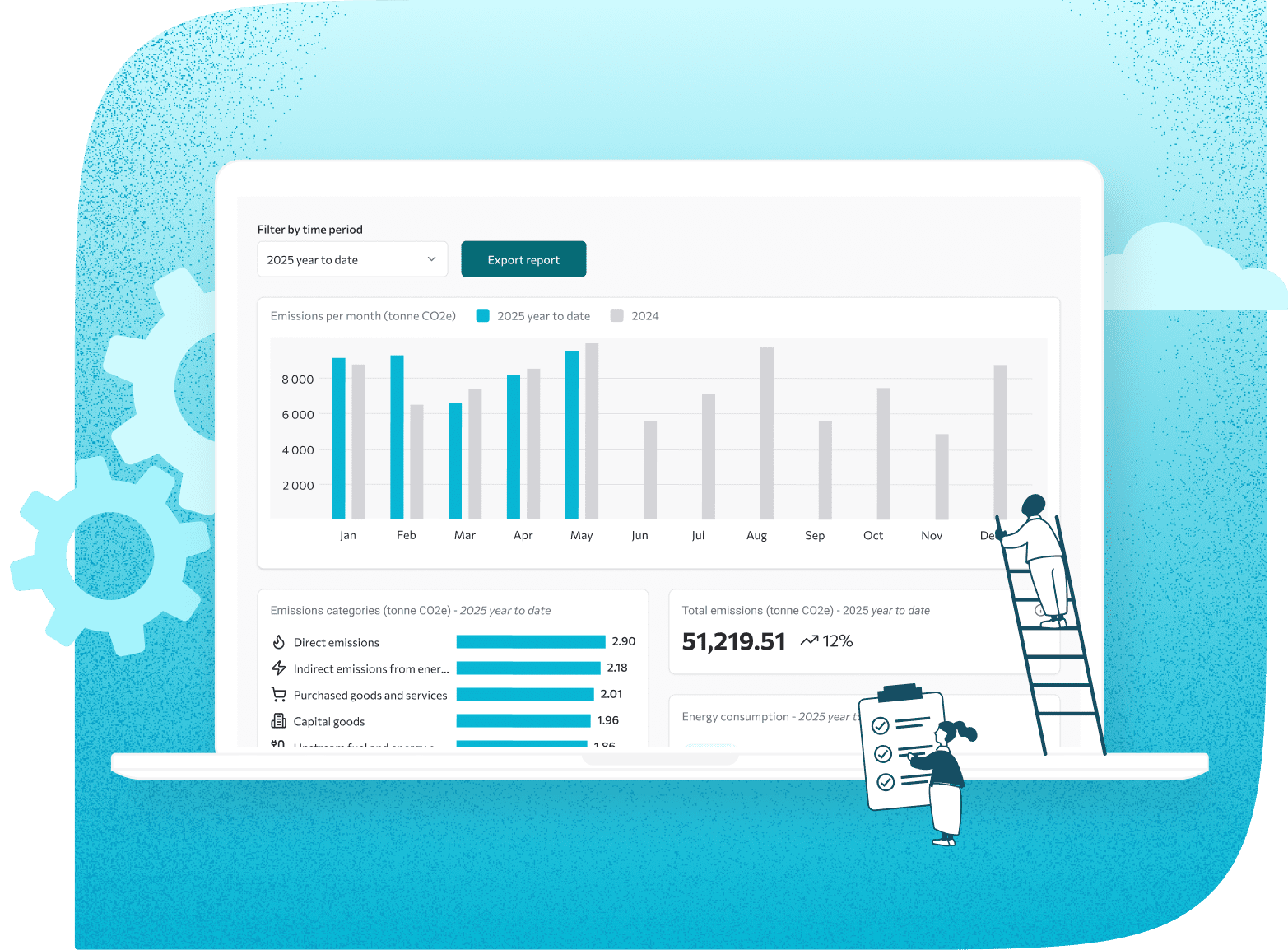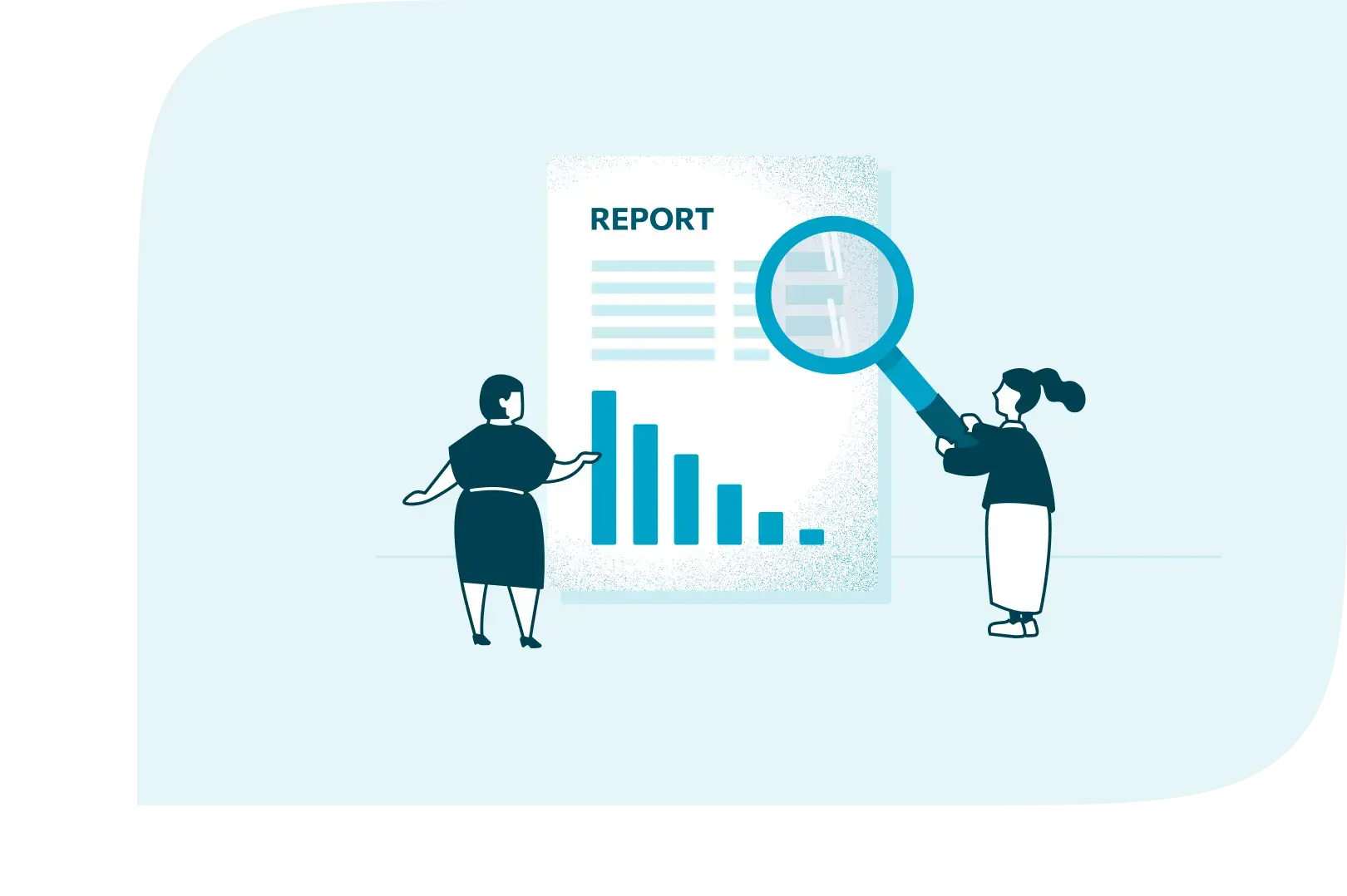Take control of your carbon accounting with Visma
● Get everything in one system.
● Save time with automatic data collection from Visma accounting and Visma Expense.
● Download your carbon report for Scope 1, 2, and 3 in Excel, with detailed supporting documentation.
● The report is aligned with the GHG Protocol, CSRD, ESRS, NSRS, and VSME.

.png)
Everything in one place
Get a climate report based on financial data and travel data from Visma and Visma Expense.
Everything gathered in one place, with a single login.
%20(4).webp)
Make the most of the data
you already have
Forget Excel and manual data collection. Visma already contains the most important foundation for your climate report.
Connect climate data to purchases, costs, and employee travel, and get a complete overview of emissions across
Scope 1, 2, and 3.

Take control of employee
travel emissions
More than 13,000 companies have already enabled emissions calculation in Visma Expense. Enable “emissions” and get emissions calculated directly from your expense claims.
This gives you accurate activity data for Scope 3 and a more precise climate report.

The most time-consuming part of reporting is data collection. We extract the data and convert it into greenhouse gas emissions.This makes you more efficient and reduces manual work.
Purchases, costs, and employee travel are seamlessly connected to the carbon accounting tool. You don’t need new systems. Everything happens through the systems you already work in.
No prior knowledge is required. The tool is developed for finance and sustainability managers who want clear emissions figures in Visma, in a format you already know.
Activate Climate Reporting directly in Visma Home. Your accounting data is then automatically collected and converted into a complete climate report, directly within your ERP system.
Not using Visma? Get in touch, and we’ll help you get started using a SAF-T file from the system you use today.
A climate report gives you an overview of your emissions and a clear basis for decision-making. More and more customers, tenders, and partners now request climate data before choosing a supplier. Without a report, you may, in the worst case, be excluded from the competition.
Although legal requirements for many companies will apply from spring 2028, expectations come much earlier. A climate report builds trust with stakeholders, meets market expectations, and can provide an important competitive advantage.
In short: A climate report helps you stay prepared and more attractive in the market. If you start now, you’ll be ready when the requirements arrive.
.webp)
Once the tool is activated, your accounting data is automatically collected. Do a quick check of the SAF-T IDs in your accounting system and fill in anything that is missing.
The tool then translates your transactions into emissions data (CO₂e) and lays the foundation for your climate report.
We calculate greenhouse gas emissions by combining the spend-based method with activity data where available. First, costs in the accounting system (SAF-T accounts) are linked to emission factors, so purchases and services are automatically converted into CO₂e and allocated across Scope 1, 2, and 3.
Where you have more precise figures, you can add activity data for fuel and energy use, which replaces the original calculations. If you use Visma Expense, activity data for employee travel is automatically collected and included in the same climate report.
This gives you a comprehensive and efficient climate report based on data you already have, without additional systems or manual data collection.

Your climate report is ready. You now have a complete climate report based on financial data and activity data. The data is always up to date through integrated systems, and emissions from employee travel flow seamlessly in from Visma Expense. This means everything is collected in one system.
Download your report and share it with owners, customers, tenders, or suppliers (without stress) when they ask for it.
Emissions from employee travel are calculated using the information registered in your expense claims. Flights, car travel, taxis, trains, and other modes of transport are converted into CO₂e based on factors such as distance, time, and transport type.
If you use Visma Expense, emissions are calculated automatically for each expense claim, and the results are added directly to your climate report.
This gives you a complete overview of emissions from employee travel, without manual data collection.

Why you should have a climate report
A climate report provides a comprehensive overview of your greenhouse gas emissions and enables you to respond efficiently to requests for climate-related data, requests that are becoming increasingly common. Customers, tendering authorities, corporate groups, and suppliers now expect organisations to be able to document their emissions. In addition, a climate report helps you prepare for and comply with current and upcoming requirements from the EU and Norwegian authorities.
Yes. The report is prepared in accordance with the Greenhouse Gas Protocol and is structured to support reporting under CSRD, NSRS and VSME. Emissions are categorised into Scopes 1, 2 and 3 and reported in tonnes of CO₂e, as required by the applicable regulations. For most Visma customers, this level of reporting provides a robust and practical foundation for meeting the expectations of owners, customers, banks, and tender processes.
.png)
Suppliers to larger companies
SMEs supplying to larger companies will need to demonstrate their sustainability efforts to maintain business relationships with their bigger companies.
Participants in public tenders
When relevant, you must submit a climate report to compete for tenders. We assist with the reporting so you don’t miss out on contract opportunities.
Those seeking financing or better loan terms
Several banks require climate reporting for loan applications. We make it easy to meet these requirements, securing financing and better loan terms.
Companies working on sustainability goals
Are you working on sustainability and want to document your efforts? Climate reports show you are taking responsibility for your emissions.
Climate reporting in Visma is a fast and simple way for Visma customers to get a climate report and a GHG report directly within their ERP system. You activate the solution in Visma Home, and the tool automatically collects accounting data to calculate emissions in CO₂e.
Costs and purchases are translated into emissions across Scope 1, 2, and 3 using a mix of spend-based and activity-based methods. You can do a quick quality check and adjust categories or add activity data where needed.You then download a complete climate report in Excel, ready to be shared with owners, customers, tenders, or group companies.
The tool automatically collects relevant accounting data from your Visma solutions and uses it as the basis for your climate report and climate reporting. This includes transactions, costs, and purchases across different accounts, as well as travel data from Visma Expense. These data are translated into greenhouse gas emissions in CO₂e and categorised across Scope 1, 2, and 3 using the spend-based method.
If you use Visma Expense, emissions from employee travel flow seamlessly into the report as an important input for accurate Scope 3 reporting. The data is updated in line with your accounting data, so you always have an up-to-date GHG report ready when someone asks.
Emissions from employee travel in Visma Expense are calculated automatically for each expense claim, based on the information registered by the employee and the data included in receipts. Flights, car travel, taxis, trains, and other types of travel are translated into greenhouse gas emissions in CO₂e based on travel time, distance, and mode of transport. This provides a solid basis for Scope 3 employee travel in your climate report and GHG report.
The emissions calculation only requires employees to register one additional item in their usual expense claim. The Visma Expense integration works across Visma solutions and sends travel emissions directly into your Visma system.
This means your climate report is built on data you already have, without manual data collection.
We calculate greenhouse gas emissions by combining the spend-based method with activity data where available. First, costs in the accounting system (SAF-T accounts) are linked to emission factors, so purchases and services are automatically converted into CO₂e and allocated across Scope 1, 2, and 3.
Where more precise figures are available, you can add activity data for fuel and energy use, which replaces the original calculations. If you use Visma Expense, activity data for employee travel is automatically collected and included in the same climate report.
This results in a comprehensive and efficient climate report based on data you already have, without additional systems or manual data collection.
Yes. Climate reporting in Visma gives you Scope 1, 2, and 3 combined in one single climate report. The report is based on accounting data and other relevant data sources in Visma, and provides a comprehensive climate report in a GHG report format, with emissions presented in kilograms and tonnes of CO₂e.
You can download the report in a clear and easy-to-read Excel format, ready to be shared with owners, customers, tenders, group companies, or suppliers.
Yes. The climate report from climate reporting in Visma follows the GHG Protocol, the most widely used standard for measuring and reporting greenhouse gas emissions. The report is also aligned with CSRD, ESRS, NSRS, and VSME.
Emissions are clearly structured across Scope 1, 2, and 3 and reported in kilograms and tonnes of CO₂e. This results in a GHG report that is easy to understand and simple to share.
Yes. You can adjust emission figures in your climate report using activity data based on energy indicators, enabling more precise calculations for Scope 1 and 2. This allows climate reporting in Visma to be based on actual energy and fuel consumption, where you have better data than estimates.
For Scope 3 employee travel, you can enable emissions calculation in Visma Expense. Emissions are then calculated automatically for each expense claim, and the data flows directly into your climate report and GHG report, without manual data collection.
You can contact your usual Visma partner to activate climate reporting in Visma. You can also get in touch with us, or one of the partners listed below. They can help you get started with carbon accounting and a GHG report directly within your Visma solutions.
Our partners:
Visma Software Nordic
Tripletex
Business NXT
PowerOffice
Abacus IT
Cloud Connection
Exsitec
Proplan
Columbi
We process all data in accordance with GDPR and our data processing agreement. Personal data is stored on secure servers and protected through technical, physical, and organisational measures designed to ensure confidentiality, integrity, and availability.
Only authorised employees and sub-processors who require access to operate the service can access the data, and all are subject to strict confidentiality obligations. We use sub-processors that operate under their own data processing agreements. For climate reporting, we do not transfer personal data outside the EU/EEA.
If you would like more detailed information, you can read our Terms of Service and Privacy Policy, or contact our Data Protection Officer at gdpr@ducky.eco.
Terms of service
Our privacy policy
